Hint: Compare the features of herbs, shrubs & trees, considering their physical
features/appearance.
Question.1. A student wants to identify a shrub in a garden, but he is getting confused between an herb and a shrub. Which characteristics of the plant will help the student identify the shrub?
(a) Green stems
(b) Hard and thick stems
(c) Branches developed at the base of the stem
(d) Branches developed in the upper part of the stem
Question.2. The table shows classification of plants in various categories done by a student after reading their characteristics.
(a) Plant 1
(b) Plant 2
(c) Plant 3
(d) Plant 4
Ans.1. (c) Branches developed at the base of the stem
Ans.2. (c) Plant 3
Hint: Analyse the parts of a plant and their function in order to classify them into root and shoot system.
Question.3. The root system and the shoot system of a plant play different roles. Which of the following functions does NOT relate to the shoot system?
(a) Transpiration
(b) Flower development
(c) Provide site for photosynthesis
(d) Absorption of nutrients from the soil
Question.4. The table list some functions of different plant parts.
(a) 2
(b) 3
(c) 4
(d) 5
Question.5. The table list some functions of different plant parts.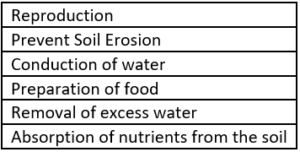
(a) 2
(b) 3
(c) 4
(d) 5
Ans.3. (d) Absorption of nutrients from the soil
Ans.4. (b) 3
Ans.5. (c) 4
Hint: List the characteristics of plants in order to classify them into creepers and climbers.
Question.6. The image shows a watermelon plant.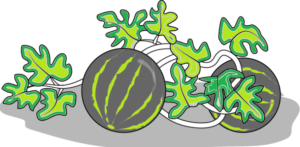
(a) Yes. The plant has green stems, so it is an herb.
(b) Yes. The plant has many branches, so it is an herb.
(c) No. The plant has weak stems and spreads on the ground, so it is a creeper.
(d) No. The plant has weak stems which are supporting the watermelon on the ground, so it is a climber.
Question.7. A farmer designed a home vineyard to plant grapevines, as shown in the image.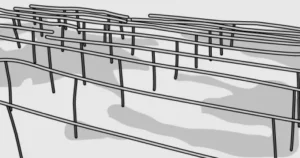
(a) To make the yard beautiful as grapes flowers will cover all these poles
(b) To manage the space as some other plants can be grown on the ground
(c) To provide equal space to each grapevine as these require lot of ground to grow
(d) To get good productivity of grapes as grapes vines are climbers which need supports to climb upward
Ans.6. (c) No. The plant has weak stems and spreads on the ground, so it is a creeper.
Ans.7. (d) To get good productivity of grapes as grapes vines are climbers which need supports to climb upward
Hint: Apply knowledge of parts of a plants to decipher features of a different plant/
specimens.
Question.8. A student pulled an herb out of the soil and observed that a plant part came out with it.
Some hair-like structures were coming out from that part. What could be the plant part?
(a) Flower
(b) Leaf
(c) Stem
(d) Root
Question.9. Ramesh wants to collect that part of a plant which contains its reproductive parts. What features would be possessed by that plant part?
(a) Presence of Midrib
(b) Presence of stomata
(c) Presence of root hairs
(d) Presence of petals and sepals
Ans.8. (d) Root
Ans.9. (d) Presence of petals and sepals
Hint: Examine stems of different plants and design activities to demonstrate water
conduction through stem (from roots).
Question.10. A student cuts a twig of a plant. After making the cut, the student observed a drop of water collected at its end. What could be the reason for the appearance of this drop of water?
(a) Conduction of water through the stem
(b) Transpiration of water through the stem
(c) Formation of dew due to water condensation
(d) Absorption of water by the stem from the surroundings
Question.11. Ravi conducted an experiment in which he filled a glass with one-third of the water. He added a drop of red ink into that glass and then stirred it for few minutes. After that he made an oblique cut at the base of the stem of a tender twig and then put it into the water as shown in the image.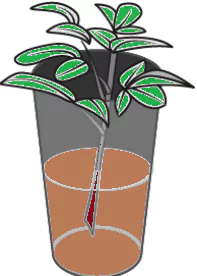
(a) Shedding of leaves from the stem
(b) Rise of the colour into the stems
(c) Development of red coloured roots
(d) Development of more branches at the stem
Ans.10. (a) Conduction of water through the stem
Ans.11. (b) Rise of the colour into the stems
Hint: Identify different parts of leaf.
Question.12. A student observed some leaves that were attached to a stem, as shown in the image.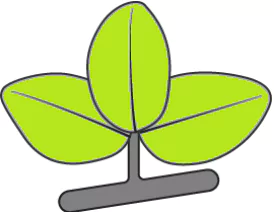
(a) Lamina
(b) Midrib
(c) Petiole
(d) Veins
Question.13. The image shows an unlabelled diagram of leaf.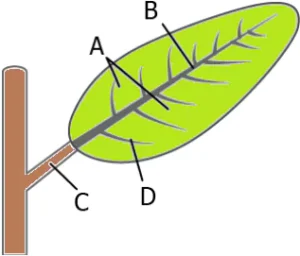
(a) 


Ans.12. (c) Petiole
Ans.13. (d)
Hint: Recognize patterns on leaves of different plants in order to classify them into
reticulate and parallel venations.
Question.14. A student took a leaf from a mango plant and started to take its impression with the help of a pencil and paper. The image shows the impression of the mango leaf.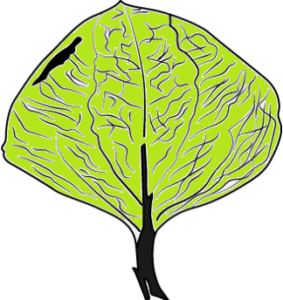
(a) Parallel venation; as the obtained design represents net-like veins.
(b) Parallel venation; as the obtained design represents parallel veins.
(c) Reticulate venation; as the obtained design represents net-like veins.
(d) Reticulate venation; as the obtained design represents parallel veins.
Question.15. A student observed the leaves of different plants listed in the table.
(a) Banana and Peepal
(b) Mango and Neem
(c) Neem and Grasses
(d) Banana and Grasses
Ans.14. (c) Reticulate venation; as the obtained design represents net-like veins.
Ans.15. (d) Banana and Grasses
Hint: Demonstrate the process of transpiration in order to describe the functions of
the leaf.
Question.16. A student took a healthy, well-watered plant and enclosed a leafy branch of it in a polythene bag. After a few hours, the student observed some water drops on the inner side of the polythene bag. What likely can be concluded from this activity?
(a) Leaves help in respiration.
(b) Leaves help in transpiration.
(c) Leaves help in photosynthesis.
(d) Leaves help in the transportation of food.
Question.17. The air that surrounds a tree remains cooler in comparison with the air around an empty ground. How do trees help in making the surrounding air cooler?
(a) Trees releases oxygen during the process of respiration that makes the surrounding cool.
(b) Trees release water in gaseous form into the surrounding through a process called transpiration.
(c) Trees utilizes the heat from the surrounding to make their food through a process called photosynthesis.
(d) Trees gains the heat from the surrounding that helps in the translocation of food from the leaves to the roots.
Ans.16. (b) Leaves help in transpiration.
Ans.17. (b) Trees release water in gaseous form into the surrounding through a process called transpiration.
Hint: Explain the process of photosynthesis in order to describe the functions of the
leaf.
Question.18. The leaves of plants help it to make food by the process of photosynthesis. Plants perform photosynthesis in the presence of sunlight. What other components are needed by the plants to undergo photosynthesis?
(a) Oxygen and water
(b) Carbon dioxide and water
(c) Carbon dioxide and oxygen
(d) Oxygen and Carbon monoxide
Question.19. A student wants to perform an iodine test to determine the presence of starch in that part of the plant at which photosynthesis takes place. What part of the plant should be chosen by the student to perform the test?
(a) Roots
(b) Leaves
(c) Branches
(d) Petals of flower
Ans.18. (b) Carbon dioxide and water
Ans.19. (b) Leaves
Hint: Outline/list the functions of roots in plants with the help of activities.
Question.20. Two plants of the same kind were dug out with the roots from the soil by a student. The student planted one of these plants as is in pot 1, while cut off the roots of another plant and planted it in pot 2. The image shows plants in pot 1 and pot 2.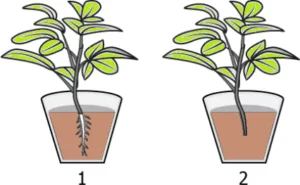
(a) Pot 1; because roots of the plant will help it by making food through photosynthesis.
(b) Pot 1; because roots of the plant will help it to absorb water and minerals from the soil.
(c) Pot 2; because the removal of the roots will decrease the nutrient demand of the plant.
(d) Pot 2; because removal of the root will not allow the plant to take toxic chemicals from the soil.
Question.21. A student performed an experiment with two pots to determine the role of roots in holding soil particles together. He planted grass in pot 1 but the pot 2 had only soil. Student watered both these pots for a week. After a week, the student placed these pots inclined under the tap water. What can likely to be observed by the student?
(a) 


Ans.20. (b) Pot 1; because roots of the plant will help it to absorb water and minerals from the soil.
Ans.21. (c)
Hint: Compare roots of different plants in order to classify them as tap roots and fibrous roots.
Question.22. The image shows two types of the plant with their root system.
(a) A-lateral root, B-tap root, C-fibrous root
(b) A-tap root, B-fibrous root, C-lateral root
(c) A-fibrous root, B-lateral root, C-tap root
(d) A-tap root, B-lateral root, C-fibrous root
Question.23. A student read out in his textbook that a pea plant possesses a tap root system and a wheat plant possesses a fibrous root system. To validate this, the student dug out a pea plant and a wheat plant from the soil. What features of the root would be observed by the student in both the plants?
(a) 


Ans.22. (a) A-lateral root, B-tap root, C-fibrous root
Ans.23. (a)
Hint: Deduce the relation between leaf venation and the types of roots in a plant in
order to deduce the type of root.
Question.24. Rishi has a small plant with him. He observed that the root of the plant was having a main root with some smaller roots. What type of the root is possessed by this plant and what type of venation will likely be observed in its leaves?
(a) Tap root; Parallel venation
(b) Tap root; Reticulate venation
(c) Fibrous root; Parallel venation
(d) Fibrous root; Reticulate venation
Question.25. The table shows some blank cells that need to be filled with the type of root and leaf venation of the respective plants.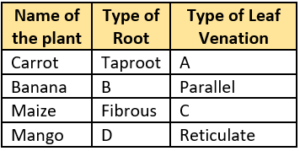
(a) 


Ans.24. (b) Tap root; Reticulate venation
Ans.25. (c)
Hint: Illustrate the structure of a (typical) flower with at least 6 labelling & elaborate on each.
Question.26. The image shows some unlabelled parts of a flower.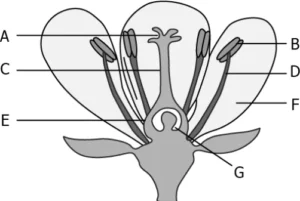
(a) B, D, G
(b) B, D, F
(c) A, C, E
(d) A, E, F
Question.27. The image shows some parts of a flower labelled as A, B, C and D.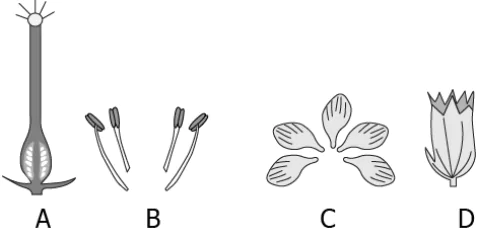
(a) 


Ans.26. (c) A, C, E
Ans.27.









